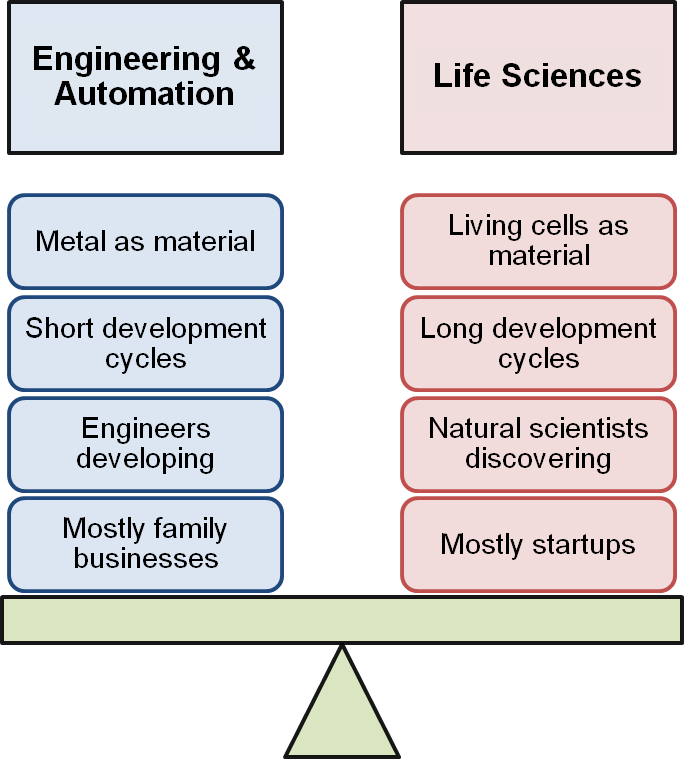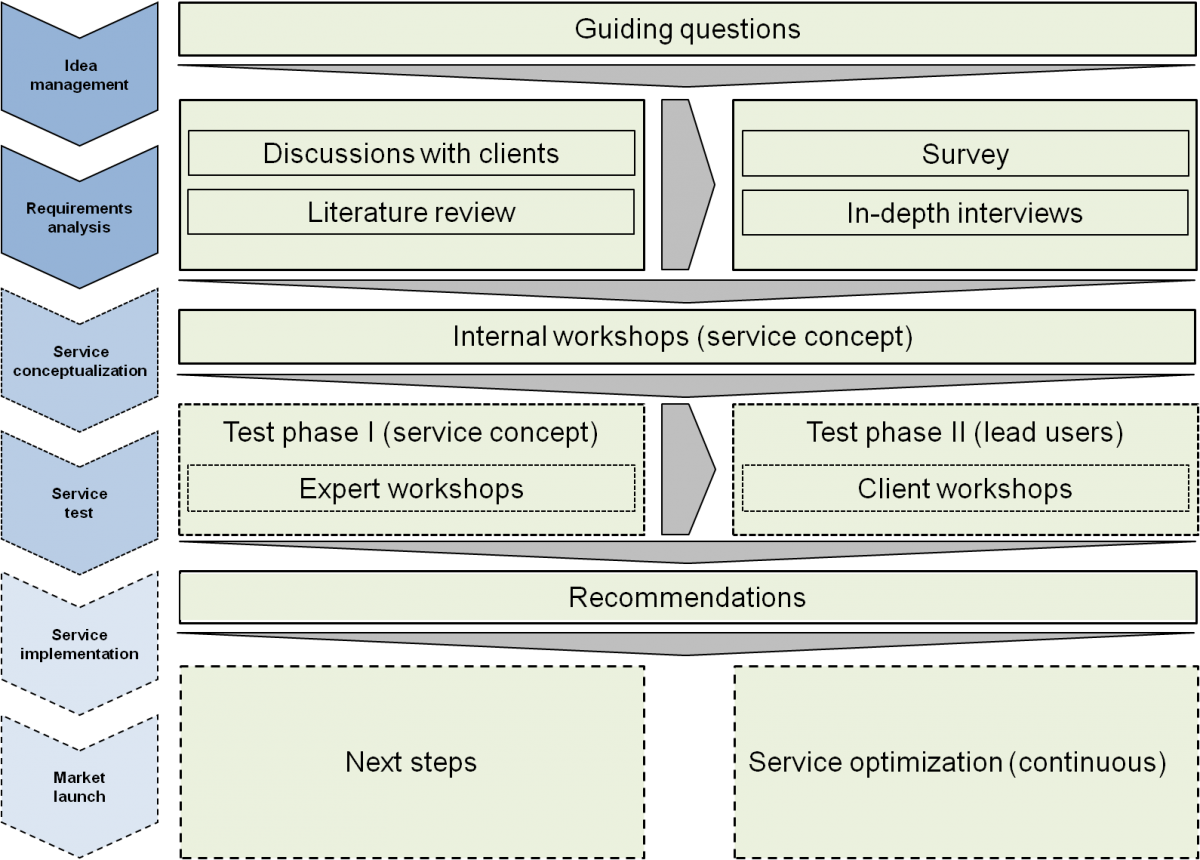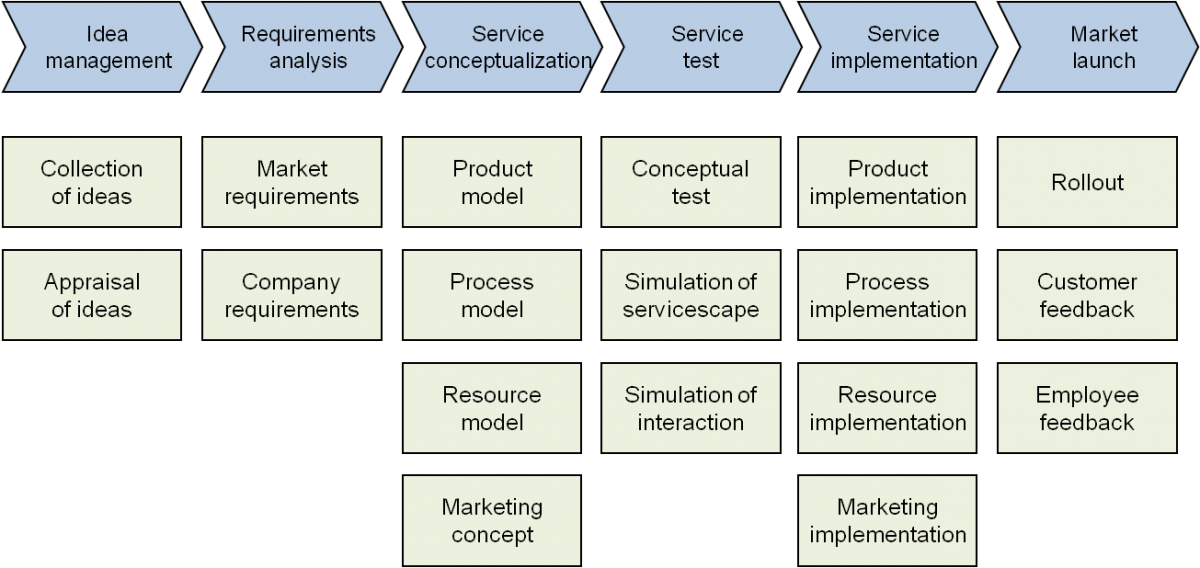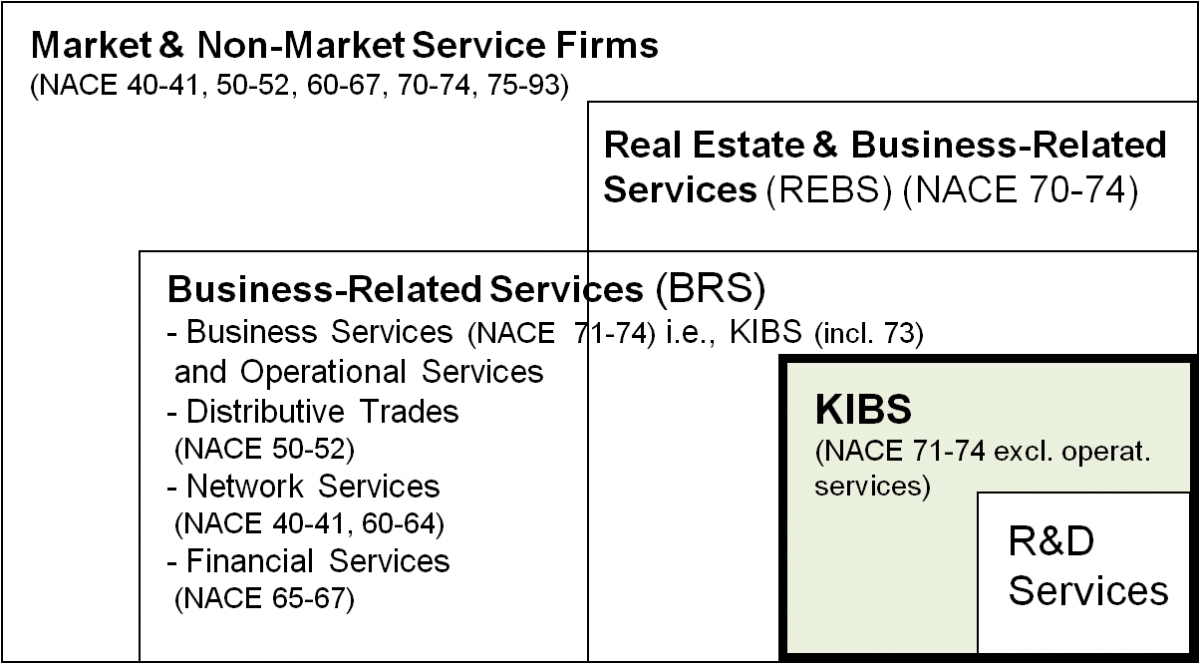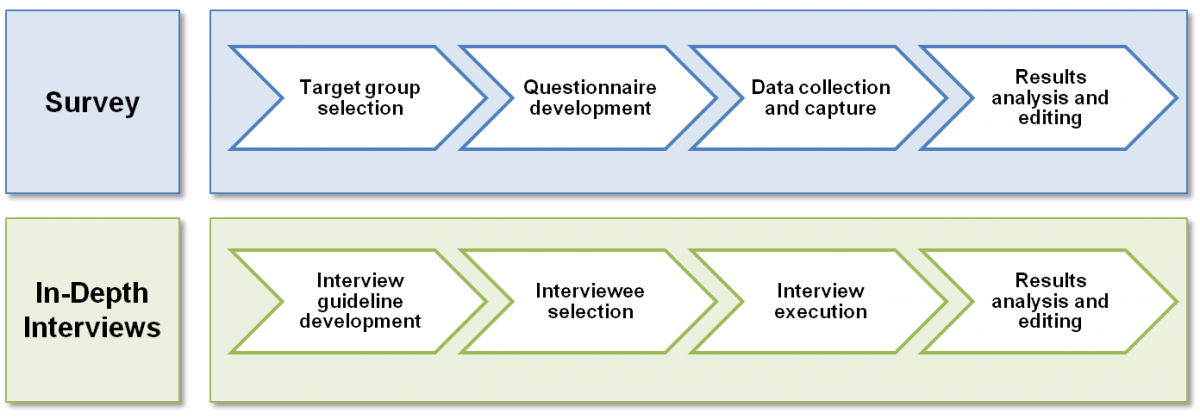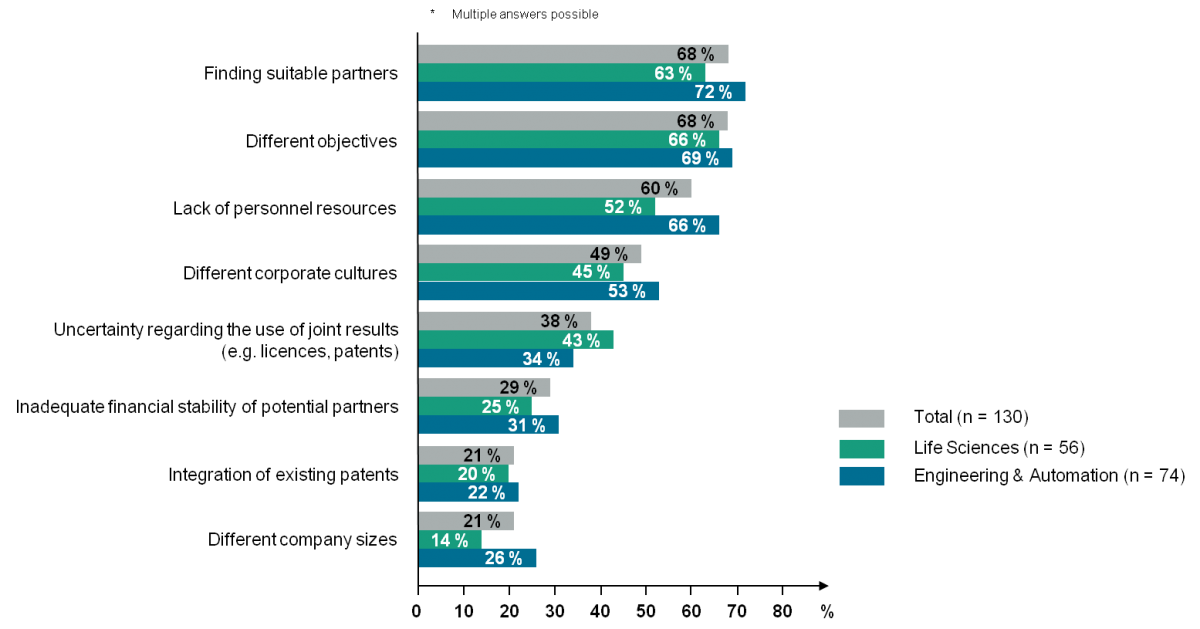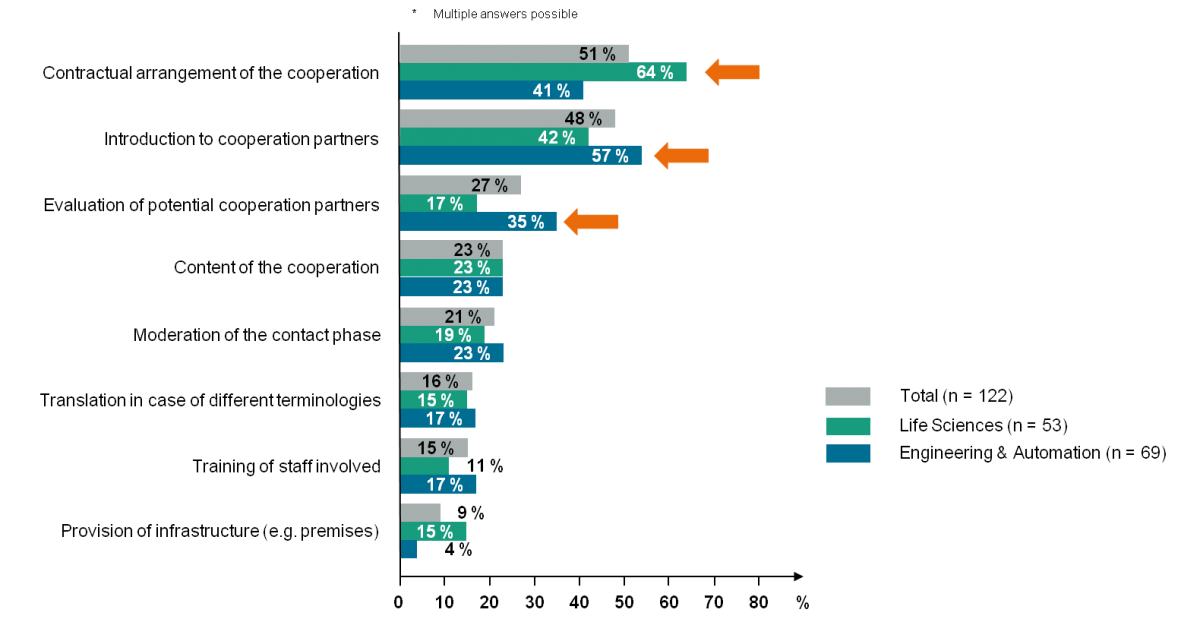AbstractThe key then to attaining this higher level of intelligence is to make our years of study qualitatively rich. We don't simply absorb information – we internalize it and make it our own by finding some way to put this knowledge to practical use.
Robert Greene
In Mastery
This article it shows the role of services in a highly interdisciplinary context: promoting cooperation between organizations in the life sciences industry and in the engineering and automation industry. It provides insights on how required offerings of knowledge-intensive business services (KIBS) are developed systematically based on a simple service engineering process model. In addition to the content-related view of new service development, findings from a meta-view are presented. Cooperating researchers and practitioners in the new-service development process observed their own collaboration and how the applied service engineering model had to be modified dynamically to the requirements of the use case. The results show that an easy-to-use service engineering model in a highly interdisciplinary context has benefits, but success is dependent on the joint efforts of an accordingly interdisciplinary team of engineers and natural scientists; a close communication with the customers both from the life sciences industry and the engineering and automation industry; and a more agile approach.
Introduction
Companies face many challenges in developing and innovating services, particularly in the domain of knowledge-intensive business services (KIBS). For example, KIBS require in-depth interaction between the service company and their customers, and therefore, these services are highly customized. Thus, the specific demand areas of the customers must be covered in service provision using special knowledge or appropriate combinations of knowledge obtained, for example, through interdisciplinarity. Although KIBS companies do not typically offer standardized services, it is useful for them to: assess the feasibility of their service ideas; analyze internal and external requirements; describe their offerings; plan required resources; model their service processes – particularly when it comes to customer interaction – and, finally, test their service concept. In particular, this last step is not yet common in practice, but it would help companies to bring a successful offering to market.
Accordingly, service researchers seek to provide both theoretical insights and practical solutions in the form of process models, guidelines, and example cases to illustrate their application. However, general, one-size-fits-all approaches may not be sufficient when new-service development seeks to bridge two disparate industries with their own cultural and linguistic norms. In such cases, a tailored approach to interdisciplinary cooperation is required. In this article, we draw upon the service engineering discipline to develop a useful framework for developing KIBS to guide users systematically through the new-service development process in an interdisciplinary context. Based on a real company’s case, we present a successful transfer of market study results into the practical application of services and how these findings can be used for extending a service engineering process towards agility and for use in the context of KIBS.
The case examined here comes from BioRegio STERN Management GmbH (Box 1), a German service company located in the federal state of Baden-Württemberg, where it supports the economic development of the life sciences industry. The service portfolio of the company falls within the category of KIBS and mainly consists of highly specialized consulting services in areas such as business development, grant applications, and corporate finance. Their target groups are business founders, entrepreneurs, and researchers in the life sciences industry. One of the main objectives of the company is to initiate cross-sector cooperation between organizations in the life sciences industry and the engineering and automation industry to expose considerable synergy potential beyond the core businesses of the portfolio companies. Both represent economically strong and important industries in Baden-Württemberg. Combining these two industries should strengthen the industrial location and help life sciences to achieve an improved economic efficiency.
|
Box 1. About BioRegio STERN Management GmbH BioRegio STERN Management GmbH is a skill-sharing network and centre that provides help and advice to founders of new businesses, entrepreneurs, and researchers in the life sciences sector in the cities of Stuttgart, Tübingen, Esslingen, and Reutlingen and the Stuttgart and Neckar-Alb regions of the federal state of Baden-Württemberg, Germany. BioRegio STERN Management GmbH represents the interests of these market players in dealings with political circles, the media, and associations, and it provides advice on grant applications and corporate financing. Key focal points include regenerative medicine, medical technology, and the automation of biotechnology. |
At present, the life sciences industry is predominantly producing small quantities using time-consuming manual processes. Given that the life sciences are frequently subjected to requirements such as efficiency, quality, reproducibility, and human safety, innovative automation solutions are gaining importance. Engineering and automation may develop customized, flexible automation solutions across the complete product-creation process (e.g., automated cell cultures, regenerative implants). Enterprises within the engineering and automation industry are active in automation technology, machine building, and mechanical engineering, which are predominant fields within the automotive industry. However, the life sciences industry offers a great economic potential for the automation industry, particularly because biotechnology is a key and interdisciplinary technology with a significant potential for growth, highly dynamic innovation, and increasing demand. To be used successfully in the life sciences industry, automation solutions should be both miniaturized and flexible in use, and they should help reduce process costs (Ballesteros & Schell, 2012).
Cooperation between the two industries is currently still in the fledgling stages. Although there is high potential for synergy, cooperation between engineers and life scientists at first glance involves a number of challenges that are due to the differences existing between the industries. The challenges include, among other factors, difficulties in finding suitable partners and stringent regulations due to current legislation. Moreover, special challenges are the different ways of working, the corporate cultures, and the specialized technical languages used in each industry. The key differences are graphically illustrated in Figure 1.
Figure 1. Differences between the engineering and automation industry and the life sciences industry (cf. Ballesteros & Schell, 2012)
As a result of these contrasts, interdisciplinary work is a prerequisite for realizing interface projects between the engineering automation industry and the life sciences industry. In this respect, an appropriate service offering is intended to provide support to both life science and engineering and automation enterprises in order to facilitate the link between these industries. To develop such a suitable offering, it is necessary to first investigate the general market and cooperation conditions because these economic waters are completely uncharted. To overcome these challenges, an appropriate service platform should be established to support projects at the interface between engineering and natural sciences.
To move from the initial state (little or only loose cooperation between companies of the two industries and no support to promote cooperation) to the desired state (more opportunities and awareness for cooperation as a consequence of promotion and consulting), BioRegio STERN Management GmbH followed a structured process that is described in the following section. The main challenge was that the service portfolio that should be developed actually has to be highly customized to single target groups or even companies with specific cooperation requirements and challenges. Nevertheless, the company needed some basic “service components” that would be useful to promote and support cooperation, and that could be adapted quickly to specific requirements. Furthermore, they needed an easy-to-use approach that would not add complexity to this interdisciplinary project. Accordingly, the company chose a process model could serve as a reference without requiring them to rigidly adhere to its every detail.
Methodology
The present article is based on a sample case from BioRegio STERN Management GmbH and describes how KIBS can be developed systematically for a previously unknown market and introduced at only a minimum of risk by choosing a structured, but agile and prototypical service engineering approach.
The methodology can be described along the phases of a new-service development process (cf. Figure 2): idea finding and evaluation, requirements analysis, service design, test, implementation, and market launch. A specific focus was on the compilation of requirements, by combining the results of a broad survey and in-depth interviews to explore best practices, and on testing the service offerings, which can be structured according to two phases. Test phase 1 focuses on the prototypical test of the service concept whereas test phase 2 uses the lead-user approach for further trial and optimization of the service offering. The company is currently still in the conceptualization and test phase. Along with the implementation and market launch, continuous optimization and customization of the offering to current requirements will be performed.
Figure 2. The new-service development approach used in the present case study
Furthermore, findings that are useful for further service research are reflected and shown explicitly in parallel to the practical development process. Hence, the sample case is a hands-on trial of a procedure model in the context of KIBS in a highly interdisciplinary environment. This approach results in new knowledge being fed back into the development process and makes it possible to recognize further needs for the development of new services.
Theoretical background
The research disciplines of new service development and service design were not recognized before the 1980s. In the 1990s, the concept of "service engineering" emerged. This concept describes the systematic development and design of services using suitable models, methods, and tools – and thus adopts to some extent the approach of product and software development common in the engineering sciences. Since the time when the research discipline emerged, numerous methods and instruments for the design of services have been developed (e.g., Bullinger et al., 2003; Bullinger & Scheer, 2003; Salvendy & Karwowski, 2010; Scheer & Spath, 2004).
Given that the sample case of BioRegio STERN Management GmbH deals with the development of new services in an entirely new market – supporting cooperation between two industries, which are (still) fairly unknown to each other – the uncertainty and the risk of undesirable developments are particularly high. The company therefore is using a systematic approach to avoid developing services that "miss the market" but rather align them with the requirements of both industries. The development and testing activities were geared to a procedure model (see Figure 3) which takes all phases of new service development into account: idea management, requirements analysis, service conceptualization, test, implementation, and market launch. This type of model was preferred by the company over other models because it was seen as a balanced solution between the required degree of detail and the desired ease of use. Also, the service developers of the company felt that they could use this model intuitively and adapt it easily to their conditions.
Figure 3. The service engineering process (adapted from Burger et al., 2010)
The present case is about KIBS representing a main challenge for the development process. KIBS and the associated sectors and sub-sectors are usually defined on the basis of the Classification of Economic Activities in the European Community (NACE, 2008) and mapped to the parameters 71 to 74 (see Figure 4) as services provided on the basis of specialized knowledge. Their provision and use could lead to a growth of knowledge (cf. Muller & Doloreux, 2007; Schnabl & Zenker, 2013; Schricke et al., 2012). In particular, consulting services fall into this category (e.g., business consulting, technology consulting, engineering, and market research). Knowledge-intensive services, also referred to as knowledge-focused services, are usually characterized by high contact intensity with customers and a high number of variants (cf. Baumgärtner & Bienzeisler, 2007). For the present sample case of BioRegio STERN Management GmbH, this characterization results in a certain complexity (e.g., the specific nature of the customer's problem and of the technical or scientific field) and interactions with the customers become necessary in the service processes (e.g., analysis of the initial situation, data collection at the customer's location, and acceptance of the result by the customer). These particular characteristics should be taken into account as early as possible during the development process.
Figure 4. Classification of knowledge-intensive business services (KIBS) in the NACE (Hertog et al., 2006)
In contrast with other concepts from services research (cf. Edvardsson & Olsson, 1996; Jaschinski, 1998; Ramaswamy, 1996; Scheuing & Johnson, 1989; Shostack & Kingman-Brundage, 1991), which are usually either sequentially or iteratively (cf. Schneider et al., 1998), the chosen service engineering model features modularity as a property. At first glance, the chosen procedure seems to be rigid and linear (i.e., without any iteration or optimization loops provided). Generally, it is said that this type of process model is rather not suitable for the development of knowledge-intensive services because there needs to be a high level of customization rather than a “ready-to-use” standard service offering. For this reason, the model was slightly modified in application, without making any change to the fundamental idea. The background for this is the concept of agile development such as it is known, for example, from software engineering. Here, iterations are provided that permit returning or jumping to other phases in order to be able to respond to errors and any optimization opportunities at an early stage; so, an incremental availability of the result is possible (Moran, 2014). Furthermore, the development process is less rigid and formal, and is characterized by a simultaneous specification from customer requirements to the actual development of the services. In the sample case, for example, iterations were inserted between idea management and the requirements analysis, between service conceptualization and test, as well as between service implementation and market launch. Furthermore, the single service offerings are adjusted dynamically to changing customer requirements and tailored to different customers during the development process. This customization is made possible by a high level of customer interaction.
Requirements Collection
The requirements analysis of the service engineering process was particularly important for the use case due to the lack of knowledge about the market requirements. These requirements are driven for example by the general attitude towards cooperation projects within and between the engineering and automation industry and the life sciences industry, and the actual potential for automation in the life sciences industry. Thus, an extensive study was conducted, including two components: a broad survey and in-depth interviews with representatives of best practice examples. The methodology is described in more detail below and is illustrated in Figure 5.
Figure 5. Methodology and components of the study
Survey
The survey was intended as the core foundation for determining market requirements and deriving a service offering to support cooperation between the two industries. Because it is a new field of study – cooperation between the two industries was uncommon before – and because of the promising prospects, this process held many challenges, which highlights the explorative nature of the survey. Target groups for the survey were decision makers (i.e., holders of strategic positions) from enterprises in both industries. In order to safeguard comparability but also to be able to address the specific aspects of both industries, the representatives of the industries were addressed with questionnaires of the same structure but with individual questions customized to the target groups. The questionnaires were made available in both printed (sent by mail) and digital (sent by email) formats and in an online version using LimeSurvey. In addition to cooperation between the life sciences industry and the engineering and automation industry, general issues relating to cooperation and specifically "cooperation within the life sciences industry“ were subjects of the study, thereby enabling the derivation of requirements and fields of action. The latter subject was particularly interesting in determining whether life sciences enterprises cooperate at all or do not usually enter into cooperation – neither within their own industry nor with other industries. The likelihood of future cooperation projects between the two industries was also studied.
Both general factors for success and failure of cooperation projects and industry-specific issues that may have an impact on the cooperative behaviour were considered when preparing the questionnaire. Individual areas of study that were subjects of the survey included, for example: cooperation projects by industries, attitude of the industries towards mutual cooperation, factors for successful cooperation, obstacles when initiating cooperation, and need for support for initiating cooperation.
The analyses were made using the statistics software IBM SPSS Statistics 20. The percentages specified refer to the valid answers. Rounding up or down may result in totals deviating slightly from 100 percent. Only those findings that had a sufficiently high significance from the statistical point of view were included in the preparation and documentation of the study results.
The survey was conducted during September and October of 2012. The scope of the study covered 131 enterprises to which 2,500 questionnaires were sent and 5% responded. Because cooperation between companies of the two different industries represents uncharted waters for their representatives, it turned out to be quite difficult receive responses to the survey. However, the number of responses was sufficient given the explorative character of the study. Forty-three percent of companies participating can be categorized to form part of the life sciences industry; 57% are from the engineering and automation industry. Most of the life science companies are from the fields of biotechnology (36%) and medical technology (38%); a smaller portion are from pharmaceutics (6%). The persons surveyed from the engineering and automation industry see themselves in the fields of automation technology (43%), machine building (35%), and engineering (24%), with some of the companies positioning themselves in more than one of the three fields, representing possible focuses.
In-depth interviews
In order to gain more profound knowledge about challenges and approaches in the cooperation between enterprises in the life sciences industry and the engineering and automation industry, semi-structured, in-depth interviews were made with two representatives from each industry. All of the total of four interview cases prepared are "lighthouse examples" of functional and fruitful cooperation. Nevertheless, obstacles surfaced that made it necessary to resort to external consulting and support in both industries from the point of view of the representatives of the companies interviewed (cf. Ballesteros & Schell, 2012).
Individual areas of study included, for example: experience from cooperation projects with the other industry, risks in cooperation projects with the other industry, solutions applied in the area of life sciences, utilization of external support when initiating cooperation projects, and criteria for the selection of cooperation partners from the other industry.
Results of the Market Study
The study revealed core findings about the two industries that are fundamental to establishing a service offering tailored to the needs of the industry and target group. First, the synergies from cooperation of both industries are recognized and there is a substantial need for consulting services regarding mutual cooperation. The factors for success determined for cooperation activities can be outlined by these keywords: building trust, interdisciplinarity, interface personnel, and professional project management. Moreover, it was possible to identify obstacles and challenges that may lead to conflicts between industry experts and that are intended to be specifically addressed by the service offering. They include, above all: financing issues, lack of contacts and ideas, lack of industry-specific know-how, different objectives and intentions, technical languages, and time horizons. It is necessary to try to find a common level of language between the two industries. In addition, finding suitable partners is an issue for many enterprises. For engineering and automation enterprises, a lack of human resources and different corporate cultures are additional obstacles for cooperation projects. Refer to Figure 6 for a summary of the results.
Figure 6. Typical obstacles when initiating cooperation projects
Important and useful instruments for initiating cooperation projects are, in particular, recommendations from existing partners. Hence, the personal component plays an important role and supports building trust. This focus is important for new service development. The second rank among useful instruments is held by personal networks of the enterprise's own employees. Hence, it is important that individual employees are able to establish contacts autonomously in order to be successful in a cooperation project. Similarly, events (e.g., conferences, meetings, fairs, and information and networking events) and activities of industry associations and networks (rated equally on an average) are among the top three useful instruments. The latter initiation instrument, however, is predominantly emphasized by enterprises with a tendency to a higher potential of innovation. Online platforms play only a minor role; the human factor is at the focus.
With regard to the need for support when initiating cooperation projects (see Figure 7), contractual issues and the procurement of cooperation partners are particularly relevant. Enterprises from the life sciences industry expressed a need for support in the contractual arrangement of the cooperation (64% versus 41% among engineering and automation enterprises). Numerous enterprises from the engineering and automation industry find ratings of potential cooperation partners useful (35%). With regard to the need for support, there is also a difference between enterprises with a high and those with a slightly lower potential for innovation. The more innovative ones, for example, think that the procurement of cooperation partners (55% versus 36%) and support in the contractual arrangement of the cooperation (52% versus 39%) are more important. Enterprises with a lower degree of innovativeness usually rate content-related support in the arrangement of the cooperation higher than the more innovative ones (30% versus 18%). Although training of employees involved is at a very low rank (15%), there is a general agreement that support is needed in this area. However, enterprises with a lower potential for innovation emphasize this aspect more than those with a higher potential for innovation (27% versus 9%). With regard to the contractual arrangement of the cooperation, need for support is expressed rather by small and medium-scale enterprises (SME) than by large-scale corporations (52% of SMEs versus 21% of corporations). In order to determine the readiness of the enterprises to enter into cooperation projects with the other industry, specific potential activities were suggested. It is striking that enterprises from the engineering and automation industry show a higher readiness to take action relating to company strategy, organization, and human resources in order to give an impetus for such cooperation. The engineering and automation enterprises already acknowledge the significance of in-house interdisciplinarity and can easily imagine hiring specialists from the domain of life sciences directly. However, given that the overall readiness is only average, it is evident that cooperation projects are currently rather based on loose constructs of individual enterprises than on close intermeshing of industries (cf. Ballesteros & Schell, 2012).
Figure 7. Need for support when initiating cooperation projects
There are also differences with regard to supply and demand of automation solutions for the life sciences industry. The life sciences enterprises were asked about applications of such solutions in order to assess which ones are currently of interest. In order to compare the demand with the supply of automation solutions for life sciences, engineering and automation enterprises were also asked about their automation solutions being used by life sciences enterprises. The results differ. For example, life sciences enterprises are currently using predominantly solutions from the fields of measurement and electrical technology (65%), microelectronics and sensor technology (60%), as well as information and communication technology (55%). In contrast, there are engineering and automation enterprises specializing particularly in the fields of production technology (64%), and robotics, development, and manufacture of single special machines (47%). At first glance, the offering of the engineering and automation enterprises and the demand on the part of the life sciences enterprises for automation solutions for life sciences diverge, however, the opinions with regard to the future importance of individual solutions are very similar. Thus, the industries will probably show a sufficient amount of future connecting factors and do not move into entirely different directions at least with regard to their expectations.
The results from the expert interviews are useful as a supplement to the broad survey and for the development of good practice examples. All in all, there is still work to be done to make the two industries aware of each other. It has also been confirmed that engineering enterprises getting into the life sciences industry need support in order to familiarize themselves with licensing regulations, market requirements, business models, and market access options. Moreover, it is important to find a suitable partner who understands one's own industry. For example, engineering and automation enterprises may have competencies in the specific fields of application of life sciences – or vice versa, life sciences enterprises may have staff that can recognize their potential for automation. Joint networking events and fairs play an important role in helping meet representatives from the other industry. However, representatives of both industries frequently tend to go to fairs of their own industry. In particular, biotechnology and medical technology specialists need to be brought closer to automation fairs. With a view to increasing the cooperation between engineering and automation industry and the life sciences industry, enterprises with a think tank function play a core role: they can complement the lack of interdisciplinary work in an enterprise and generate new automation solutions for life sciences.
Transfer of Results to the Practice of Services
Findings regarding the company’s KIBS offerings
The following requirements and needs for the development of a service offering to support cooperation between the two industries can be derived by considering the service concept and the results of the study:
- Bringing together the demand and the offering: The offerings of engineering and automation enterprises and the demands of life science enterprises for automation solutions differ. This is a starting point for new service development. This divergence can be adjusted by addressing individual companies directly. For example, a campaign could be launched to directly attract new companies from measurement and electrical technology to the market of life sciences because the need in the life sciences industry is greater than the current supply.
- Personal contacts: The human factor and direct interaction play a core role in supporting the initiation of cooperation. If a service provider merely sends information materials or provides service via telephone hotlines, online platforms, and chats, they will not get very far. It is much more important to actively facilitate interaction between potential cooperation partners. In addition, other program-specific services such as “business speed dating” or cooperation exchange may be offered as future services. An online platform may be implemented; however, the personal component should be reinforced, for example, by information events or video presentations.
- Training and workshops: This aspect is closely related to personal contacts. Although only a minority of the persons interviewed mentioned qualification issues explicitly, a need for training can be deduced implicitly. In addition to the transfer of knowledge to employees involved, particularly in companies having less experience with cooperation, or about companies of the other industry, the subject of awareness raising also plays an important role. In particular, such trainings and workshops can support engineering and automation enterprises in reducing fear of differences in corporate cultures. In this regard, a training or joint workshop proves to be more helpful than written materials such as information brochures. Other content that may be offered, such as courses, guidelines, or online tutorials, may be specifically tailored to the enterprises such as: "production and automation for natural scientists" or "life sciences for engineers". Training about the economic efficiency of projects or the design of requirements specifications and detailed specifications may also be helpful.
- Differentiation by industries: It has become evident that the two industries are more similar than expected. This similarity facilitates the arrangement and organization of shared offerings, such as events). However, there are also industry-specific needs and obstacles that have to be addressed in different ways. Whereas for life sciences enterprises (especially for SMEs), support in the contractual arrangement of cooperation projects tends to be important (i.e., when designing the cooperation), enterprises in the engineering and automation industry instead need support for the evaluation of potential cooperation partners and to reduce constraints (i.e., help in initiating contacts). Hence, automation companies need support at an even earlier stage in the process – before entering into the cooperation. However, providing an evaluation of cooperation partners as a service turns out to be difficult because, usually, there are no indicators at this point regarding the enterprises from the life sciences industry. Nevertheless, it may be beneficial to offer external project management for interface projects as a service. This service considers obstacles and constraints in the cooperation and includes them into the project management task.
- Interdisciplinarity and communication: Personnel at the interface between the two industries raise an important issue on two levels: first within the enterprises themselves and second with a view to the consulting services. Not only do the two industries need an interdisciplinarity approach to understand each other and to be able to cooperate better, they also need external service providers to support cooperation projects between the two industries. For example, a "translation service" between the two industries could be considered, either in terms of a dictionary or in terms of a personal “translator” that can be requested for project meetings to translate between the two industry languages. Such a service addresses the different specialized languages which are often a cause for failure of interdisciplinary cooperation.
- Visualization: Another potentially beneficial aspect is visualization.. For example, laboratory processes can be visualized for improved presentation, allowing the biotechnology specialist to recognize the processes and identify with automation more easily. Another example would be a biotechnology truck or exhibition events organized at enterprises that are able to show lab automation products. Rapid prototyping could also be used to present ideas visually in a quick and efficient way.
Findings regarding the service engineering process model
The individual phases of the procedure model as well as the backgrounds for customization are described below:
- Idea management and requirements analysis: In order to be able to develop and select sustainable ideas, the company first required to know the market and its requirements. This need is particularly important because the market is fairly unknown with regard to cooperation between industries. In addition, the differences between the industries had to be addressed in this phase. Each industry has its specific requirements, which have to be considered. After the first collection of ideas, on the basis of various informal interviews and a workshop with representatives of potential target groups, specific requirements were established, as described earlier with regards to the survey and in-depth interviews. The ideas were subsequently refined by supplementation, delimitation, and evaluation before making a selection. The potential advantages to customers using the service were worked out in detail. In the context of BioRegio STERN Management GmbH, the “customers” are the cluster protagonists. Because the objective is to establish further cooperation projects at the interface of life sciences and engineering and automation, the services are defined in such a way that this objective can be achieved. Those enterprises that will use the services are to be enabled to enter into a cooperation more easily.
- Service conceptualization and test: It is not possible to cover all customer groups of the target industries and service scenarios with an initial service concept because of the individual nature of the need for support between the industries and the large number of possible cooperation constellations. In order to align the service offering with the real customer needs, which may be higher than evident from the information obtained from the requirements analysis, an early concept test of the planned offerings should be made with pilot customers in workshops and individual interviews. Subsequently, the service concept is aligned with the more detailed requirements. This prototyping method prevents the enterprise from being too late in recognizing needs for adjustment and unnecessary costs (e.g., for production of sales brochures, procurement activities, purchasing external consulting services, or recruitment of new employees) that would have been incurred by a service concept that might have failed in the market.
- Service implementation and market launch: Iterations involving re-testing and re-engineering or a further development of the service offering are also provided between the last two phases – the implementation of the service and its rollout in the market. Hence, the agile approach runs throughout the complete new-service development process. BioRegio STERN Management GmbH is currently preparing for the transition to the two phases of conceptualization and test as well as implementation and market launch. The close cooperation with pilot customers or partners with a lead user role makes it possible to run these two phases nearly in parallel and upscale them for additional customers in case of successful adaptation. A critical factor may be that the market does not accept the service in spite of the conducted market analysis. A risk assessment should be carried out to accompany the new service development.
Conclusion
The application of the selected procedure model worked in the sample case without any problems although the formal model had to be adapted during use. The modular nature allowed individual adjustments and jumping between phases even though this is not depicted in the process model itself. Below, the degrees of freedom used in the model show points of departure for the further development of procedure models for new service development. The main conclusion is that the service engineering model of Burger, Kim, and Meiren (2010), including the extensive test phase, is usable as a general guide to develop KIBS. Nevertheless, there needs to be more research on how to change the representation and description of the model so that it offers additional application guidelines concerning agility and interdisciplinarity.
The degrees of freedom used in the model are as follows:
- Agile new service development, testing, and prototyping: Owing to the completely unknown market and the risk that the target groups are not yet ready for the subject matter (i.e., cooperation with a different industry), the sample case is used to approach the solution by way of prototyping. For this reason, the test phase is particularly intensive in addition to the requirements collection. All in all, an agile approach (i.e. an iterative, flexible, and highly customer-interactive procedure) plays an important role in the development of complex services. Accordingly, a more detailed investigation of the relationships and an extension of known development models by an agile concept are necessary.
- Lead user approach and customer focus: Moreover, close cooperation with lead users has turned out to be useful, particularly in connection with testing a first concept and a first specific offer. This approach can help to minimize the risk of developing offerings that "miss the market" because future needs are anticipated in time and correctly. Hence, customer focus is not only "glanced at superficially" by a compilation of obvious requirements but ensured by developing more substantial requirements into the service. In this way, customers develop from the passive role of mere informants and objects of study into development partners. Given that such lead users want to actively drive the development of innovative products and services themselves, the development project becomes more dynamic and economically more efficient for the service provider. A future subject of study in this context is how such lead users are identified and how points of interaction within the development process of a service can be defined and visualized.
- Awareness raising and marketing in "early markets": The model includes the establishment of a marketing concept for the new services in parallel to the development of the service concept. In the case of BioRegio STERN Management GmbH, the focus is predominantly on raising the awareness of the target groups (life sciences enterprises and engineering and automation enterprises), most of which first have to be made aware of the advantages of cooperation with the other industry. In this respect, the importance of areas such as business communication, marketing and sales and, in particular, collaboration in close development partnerships with potential customers can take in the development process needs further attention. It should be demonstrated which variation of the development model allows an early push into markets where the needs are not known. It is also possible to show mechanisms for how experience gathered by lead users can be communicated efficiently to other potential customers in order to facilitate the roll-out of the service in the market.
- Interdisciplinarity: The case of BioRegio STERN Management GmbH has shown that the interdisciplinarity requirement can be covered by service offerings, in this case for the collaboration between the engineering and natural scientific disciplines. In the sample case, interdisciplinarity already exists in the service development process. Other research activities could investigate the role of services at interfaces and optimum compositions of developer teams for services in different areas (e.g., joining designers with natural scientists).
Service research offers many solutions or starting points for companies to solve challenges in service business. Typically, these solutions come in the form of process models (e.g., service engineering model) and guidelines (e.g., how to actually apply a service engineering model). Nevertheless, listening to feedback from practitioners and adapting theoretical approaches dynamically to real use cases is essential for service researchers. Furthermore, a systematic test phase for a new service should never be omitted. Although KIBS are seen as rather non-standardizable in contrast to automated services or physical products, there should be an effort to test and evolve the service concept. A test could be conducted together with close customers to really tailor the services to their needs and represents the first “acid test” before rolling a new service out on the market. As this article has shown, the service engineering discipline provides a useful framework for developing knowledge-intensive (business) services to guide users systematically through the new-service development process, but it has to be carefully adapted during use.
Acknowledgements
The results outlined in the present article are based on partial results of the Engineering – Life Sciences – Automation (ELSA) Cluster Initiative. ELSA is supported by the Ministry of Finance and Economics of Baden-Württemberg, Germany, with funds from the European Regional Development Fund (ERDF).
An earlier version of this article was presented at the 2014 Annual Conference of the European Association for Research on Services (RESER), which was held from September 11th to 13th in Helsinki, Finland. RESER is a network of research groups and individuals active in services research and policy formulation.
References
Ballesteros Katemann, K, & Schell, S. 2012. New Impetus for High-Tech Sectors. Stuttgart: BioRegio STERN Management GmbH.
Baumgärtner, M., & Bienzeisler, B. 2007. Dienstleistungsproduktivität. Konzeptionelle Grundlagen am Beispiel interaktiver Dienstleistungen. Stuttgart: Fraunhofer.
Bullinger, H.-J., Fähnrich, K.-P., & Meiren, T. 2003. Service Engineering – Methodical Development of New Service Products. International Journal for Production Economics, 85(3): 275–287.
http://dx.doi.org/10.1016/S0925-5273(03)00116-6
Bullinger, H.-J., & Scheer, W. (Eds.) 2003. Service Engineering. Entwicklung und Gestaltung innovativer Dienstleistungen. Berlin: Springer.
Burger, T., Kim, K.-J., & Meiren, T. 2010. A Structured Test Approach for Service Concepts. International Journal of Service Science, Management, Engineering, and Technology, 1(4): 12–21.
Edvardsson, B., & Olsson, J. 1996. Key Concepts for New Service Development. The Service Industries Journal, 16(2): 140–164.
http://dx.doi.org/10.1080/02642069600000019
Hertog, P. den, Bouwman, H., Gallego, J., Green., L., Howells, J, Meiren, T., Miles, I., Moerschel, I., Narbona, A., Rubalcaba, L., Segers, J., & Tether, B. 2006. Research and Development Needs of Business Related Service Firms: RENESER Project Report. Utrecht: Dialogic Innovatie & Interactie.
Jaschinski, C. 1998. Qualitätsorientiertes Redesign von Dienstleistungen. Dissertation from RWTH Aachen University.
Kingman-Brundage, J., & Shostack, L. G. 1991. How to Design a Service. In C. A. Congram & M. L. Friedman (Eds.). The AMA Handbook of Marketing for the Service Industries: 243–261. New York: American Management Association.
Moran, A. 2014. Agile Risk Management. Springer Briefs in Computer Science. London: Springer.
Muller, E., & Doloreux, E. 2007. The Key Dimensions of Knowledge-Intensive Business Services (KIBS) Analysis: A Decade of Evolution. Working Papers "Firms and Region", No. U1/2007. Karlsruhe, Germany: Fraunhofer Institute for Systems and Innovation Research (ISI).
NACE. 2008. Statistical Classification of Economic Activities in the European Community, Rev. 2. Luxembourg: Statistical Office of the European Communities.
Ramaswamy, R. 1996. Design and Management of Service Processes. Boston: Addison-Wesley Publishing Company.
Salvendy, G., & Karwowski, W. (Eds.). 2010. Introduction to Service Engineering. New Jersey: John Wiley & Sons, Inc.
http://dx.doi.org/10.1002/9780470569627
Scheer, A.-W., & Spath, D. (Eds.) 2004. Computer Aided Service Engineering. Berlin: Springer.
http://dx.doi.org/10.1007/978-3-642-17010-2
Schnabl, E., & Zenker, A. 2013. Statistical Classification of Knowledge-Intensive Business Services (KIBS) with NACE Rev. 2. evoREG Research Note #25.
Schneider, K., Daun, C., Behrens, H., & Wagner, D. 2002. Vorgehensmodelle und Standards zur systematischen Entwicklung von Dienstleistungen. H.-J. Bullinger & A.-W. Scheer (Eds.). Service Engineering. Entwicklung und Gestaltung innovativer Dienstleistungen: 113–138. Berlin: Springer.
Schraft, R.D., & Kaun, R. 1998. Automatisierung der Produktion. Berlin: Heidelberg Springer Verlag.
Scheuing, E. E., & Johnson, E. M. 1989. A Proposed Model for New Service Development. Journal of Services Marketing, 3(2): 25–34.
http://dx.doi.org/10.1108/EUM0000000002484
Schricke, E., Zenker, A., & Stahlecker, T. 2012. Knowledge-Intensive (Business) Services in Europe. Brussels: European Commission.
Shostack, H. L. 1984. Designing Services That Deliver. Harvard Business Review, 62: 133–139.
Zimmermann, A. 2011. Kooperationen erfolgreich gestalten. Stuttgart: Schäffel-Poeschel Verlag.
Keywords: agile, engineering and automation, interdisciplinarity, KIBS, knowledge-intensive business services, life sciences, new service development, service engineering

